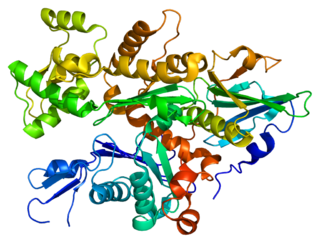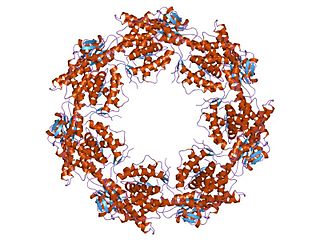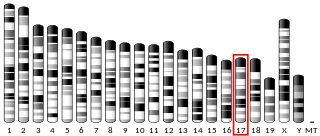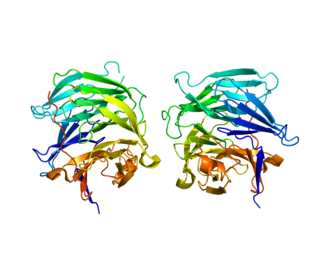
In the field of cell biology, TNF-related apoptosis-inducing ligand (TRAIL), is a protein functioning as a ligand that induces the process of cell death called apoptosis.

Gelsolin is an actin-binding protein that is a key regulator of actin filament assembly and disassembly. Gelsolin is one of the most potent members of the actin-severing gelsolin/villin superfamily, as it severs with nearly 100% efficiency.
Calcium-binding proteins are proteins that participate in calcium cell signalling pathways by binding to Ca2+, the calcium ion that plays an important role in many cellular processes. Calcium-binding proteins have specific domains that bind to calcium and are known to be heterogeneous.

Heat shock proteins are generally responsible for preventing damage to proteins in response to high levels of heat. Heat shock proteins are classified into six major families based on their molecular mass: small HSPs, HSP40, HSP60, HSP70, HSP90, and HSP110

Heat shock 70 kDa protein 1, also termed Hsp72, is a protein that in humans is encoded by the HSPA1A gene. As a member of the heat shock protein 70 family and a chaperone protein, it facilitates the proper folding of newly translated and misfolded proteins, as well as stabilize or degrade mutant proteins. In addition, Hsp72 also facilitates DNA repair. Its functions contribute to biological processes including signal transduction, apoptosis, protein homeostasis, and cell growth and differentiation. It has been associated with an extensive number of cancers, neurodegenerative diseases, cell senescence and aging, and inflammatory diseases such as Diabetes mellitus type 2 and rheumatoid arthritis.

Peptidylprolyl isomerase A (PPIA), also known as cyclophilin A (CypA) or rotamase A is an enzyme that in humans is encoded by the PPIA gene on chromosome 7. As a member of the peptidyl-prolyl cis-trans isomerase (PPIase) family, this protein catalyzes the cis-trans isomerization of proline imidic peptide bonds, which allows it to regulate many biological processes, including intracellular signaling, transcription, inflammation, and apoptosis. Due to its various functions, PPIA has been implicated in a broad range of inflammatory diseases, including atherosclerosis and arthritis, and viral infections.

DnaJ homolog subfamily A member 3, mitochondrial, also known as Tumorous imaginal disc 1 (TID1), is a protein that in humans is encoded by the DNAJA3 gene on chromosome 16. This protein belongs to the DNAJ/Hsp40 protein family, which is known for binding and activating Hsp70 chaperone proteins to perform protein folding, degradation, and complex assembly. As a mitochondrial protein, it is involved in maintaining membrane potential and mitochondrial DNA (mtDNA) integrity, as well as cellular processes such as cell movement, growth, and death. Furthermore, it is associated with a broad range of diseases, including neurodegenerative diseases, inflammatory diseases, and cancers.

Diablo homolog (DIABLO) is a mitochondrial protein that in humans is encoded by the DIABLO gene on chromosome 12. DIABLO is also referred to as second mitochondria-derived activator of caspases or SMAC. This protein binds inhibitor of apoptosis proteins (IAPs), thus freeing caspases to activate apoptosis. Due to its proapoptotic function, SMAC is implicated in a broad spectrum of tumors, and small molecule SMAC mimetics have been developed to enhance current cancer treatments.

Deleted in Liver Cancer 1 also known as DLC1 and StAR-related lipid transfer protein 12 (STARD12) is a protein which in humans is encoded by the DLC1 gene.

Histidine triad nucleotide-binding protein 1 is a protein that in humans is encoded by the HINT1 gene. It is a haploinsufficient tumor suppressor gene that inhibits the Wnt/β-catenin pathway in colon cancer cells and microphthalmia-associated transcription factor (MITF) activity in human mast cells. In the LysRS-Ap4A-MITF signaling pathway, HINT1 inhibits the MITF transcriptional activity by direct association. Upon pathway activation, HINT1 is released from MITF by diadenosine tetraphosphate (Ap4A), produced by LysRS.

Fetal and Adult Testis-Expressed 1, encoded by the FATE1 gene in humans, is a protein identified as a cancer-testis antigen (CTA) in hepatocellular carcinomas and gastric and colon cancers. It is testis-specific in the fetus. In adults, it is expressed predominantly in the testis and adrenal glands, with some expression in the lungs, heart, kidneys and throughout the brain.

Mitochondrial Rho GTPase 1 (MIRO1) is an enzyme that in humans is encoded by the RHOT1 gene on chromosome 17. As a Miro protein isoform, the protein facilitates mitochondrial transport by attaching the mitochondria to the motor/adaptor complex. Through its key role in mitochondrial transport, RHOT1 is involved in mitochondrial homeostasis and apoptosis, as well as Parkinson’s disease (PD) and cancer.

Mitochondrial Rho GTPase 2 is an enzyme that in humans is encoded by the RHOT2 gene. As a Miro protein isoform, the protein facilitates mitochondrial transport by attaching the mitochondria to the motor/adaptor complex. Through its key role in mitochondrial transport, RHOT2 is involved in mitochondrial homeostasis and apoptosis, as well as Parkinson’s disease (PD).

ADP/ATP translocase 4 (ANT4) is an enzyme that in humans is encoded by the SLC25A31 gene on chromosome 4. This enzyme inhibits apoptosis by catalyzing ADP/ATP exchange across the mitochondrial membranes and regulating membrane potential. In particular, ANT4 is essential to spermatogenesis, as it imports ATP into sperm mitochondria to support their development and survival. Outside this role, the SLC25AC31 gene has not been implicated in any human disease.

Arenobufagin is a cardiotoxic bufanolide steroid secreted by the Argentine toad Bufo arenarum. It has effects similar to digitalis, blocking the Na+/K+ pump in heart tissue.

Regucalcin is a protein that in humans is encoded by the RGN gene

ADP/ATP translocase 2 is a protein that in humans is encoded by the SLC25A5 gene on the X chromosome.

FAST kinase domain-containing protein 1 is a protein that in humans is encoded by the FASTKD1 gene on chromosome 2. This protein is part of the FASTKD family, which is known for regulating the energy balance of mitochondria under stress. FASTKD1 is also an RNA-binding protein and has been associated with endometrial cancer.

Regulator of microtubule dynamics protein 3 (RMDN3), more commonly known as Protein tyrosine phosphatase interacting protein 51 (PTPIP51), is a protein that in humans is encoded by the RMDN3 gene on chromosome 15. This protein contributes to multiple biological functions, including cellular differentiation, proliferation, motility, cytoskeleton formation, and apoptosis, and has been associated with numerous cancers.

Coiled-coil-helix-coiled-coil-helix domain containing 2 is a protein that in humans is encoded by the CHCHD2 gene.





















